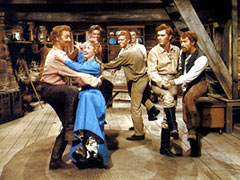Editor’s Note: With the Academy Awards just over a week away, TLNT asked some prominent thought leaders to write about their favorite movie with a management or HR theme. We’ll feature one a day up to the Oscar ceremony on Feb. 27.
By China Gorman
Seven Brides for Seven Brothers is a 1954 movie musical that was an Oscar nominee for Best Picture that year.
It’s the story of an 1850’s backwoodsman in Oregon named Adam Pontipee and his new bride, Milly. Adam spies Milly in the local “restaurant” during one of his infrequent trips into town, woos her, and despite knowing each other just a few hours, they marry.
When they arrive home – the proverbial cabin in the woods – Milly discovers that she not only has a husband, she also has six brothers-in-law. All seven brothers are unpolished, unkempt, ill-mannered and extremely good looking red-heads. The brothers-in-law look to Milly to teach them manners and how to dance, as they all want to go into town and bring home a bride as their eldest brother did.
It’s a great story based on the Roman legend of The Rape of the Sabine Women with choreography ahead of its time, great mountain winter scenery, and the charismatic lead actors Howard Keel and Jane Powell. This has long been one of my favorite movies.
So how does it relate to business and HR?
Well, we could talk about the charismatic CEO (Adam Pontipee played by Howard Keel) whose big picture thinking fails to take into account the actual impact of change on his organization. Or the relationships that CEOs needs to have with quick-thinking, reality-dealing, principled CHROs (Milly Pontipee played by Jane Powell). Or selection processes that are 100 percent intuition based (Adam meets and marries Milly in one day) – or worse, involve kidnapping.
This movie is a gorgeous metaphor for the kind of charismatic CEO leadership that creates values focused on personal gain and loses sight of the reality and needs of the day-to-day lives of their employees. It doesn’t hurt that Howard Keel could sing like nobody’s business and was his day’s Tom Selleck (really dating myself with that reference). Nor did it hurt that Jane Powell could sing like an angel and convince us of her character’s strong spine in one glance.

So let’s look at one of the film’s great plot lines. The six younger brothers, totally entranced by their oldest brother’s ability to spin a tale, follow his lead by taking a wagon into town in the dead of night (through a treacherous snow covered mountain pass) and kidnapping the six young women with whom they’re in love. With frightened, screaming, kidnapped females loaded into the wagon, and having passed through the pass, they cause an avalanche trapping the women and their suitors in their mountain home for the remainder of the winter..
We all know organizations whose no-holds barred approach to hiring makes no connection to engagement (pardon the pun) and retention. Akin to kidnapping, these organizations lure unwitting applicants with big promises of meaningful work, developmental opportunities and big bucks – and then only the some bucks materialize.
Organizations have long “kidnapped” employees with promises of promotions in six months, rotational assignments out of the country, specialized training, etc., only to renege on those promises once the employee has joined the organization. Unlike the movie, most of these instances don’t have happy endings and the impact on productivity, retention and profitability are all negative.
Jane Powell’s portrayal of Milly reminds me of most HR leaders I know. She was realistic, she stood her ground, she built teams, she fostered collaboration, she protected those at risk and she produced organizational results.
None of this had the support of the CEO. In fact, it happened in spite of the CEO. And isn’t that the way in many organizations where HR leaders know what needs to be done and quietly, without fanfare, without support just figure out what the organization needs and deliver it? Improving organization effectiveness. Minimizing the impact of CEO dunder headedness. Engaging and retaining the best and the brightest by fostering collaboration and transparency.
There are lots of reasons to enjoy this movie beyond its acting, its score by Saul Chaplin and Gene De Paul, its Johnny Mercer lyrics and its Michael Kidd choreography. One of those reasons is the portrayal of the impact one person can have by stepping up for principle and managing change well.
